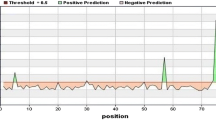Abstract
Zika fever is a disease caused by Zika virus which is a mosquito-borne flavivirus and infection is through the bite of mosquito from the Aedes genus. Other mode of transmission of Zika fever is blood transfusion, which is thoroughly investigated. Prominent symptoms of Zika virus fever are mild fever, skin rash, conjunctivitis, muscle and joint pain, malaise or headache. These symptoms normally last for 2–7 days. There is currently no effective and easily affordable vaccine available against Zika virus. Keeping the current status in mind we have devised our objectives to design a peptide-based vaccine against Zika Virus using in-silico approach. The NS3 and NS5 proteins of Zika virus are well known of having important role in replication of the virus that is why we have targeted these proteins for epitope prediction. Prediction and screening of epitopes was performed using IEDB tool. We have also checked the efficacy of these screened epitopes with the help of IC50 value and docking score. “VEMGEAAAI” was found to be the high affinity binding epitope for MHC Class I and MHC Class II molecule. These findings conclude that the predicted epitope could well be used as a potential vaccine candidate for formulations of vaccines against Zika virus.




Similar content being viewed by others

References
Alera MT, Hermann L, Tac-An IA, Klungthong C, Rutvisuttinunt W, Manasatienkij W, Lago CB (2015) Zika virus infection, Philippines, 2012. Emerg Infect Dis 21(4):722
Atif M, Azeem M, Sarwar MR, Bashir A (2016) Zika virus disease: a current review of the literature. Infection 44(6):695–705
Buathong R, Hermann L, Thaisomboonsuk B, Rutvisuttinunt W, Klungthong C, Chinnawirotpisan P, Akrasewi P (2015) Detection of Zika virus infection in Thailand, 2012–2014. Am J Trop Med Hyg 93(2):380–383
Diallo D, Sall AA, Diagne CT, Faye O, Faye O, Ba Y, Diallo M (2014) Zika virus emergence in mosquitoes in southeastern Senegal, 2011. PloS ONE 9(10):e109442
Gaunt MW, Sall AA, de Lamballerie X, Falconar AK, Dzhivanian TI, Gould EA (2001) Phylogenetic relationships of flaviviruses correlate with their epidemiology, disease association and biogeography. J Gen Virol 82(8):1867–1876
George S, Parida A (2011) Over-expression of a Rab family GTPase from phreatophyte Prosopis juliflora confers tolerance to salt stress on transgenic tobacco. Mol Biol Rep 38(3):1669–1674
Gourinat AC, O’Connor O, Calvez E, Goarant C, Dupont-Rouzeyrol M (2015) Detection of Zika virus in urine. Emerg Infect Dis 21(1):84
Henderson BR, Saeedi BJ, Campagnola G, Geiss BJ (2011) Analysis of RNA binding by the dengue virus NS5 RNA capping enzyme. PloS ONE 6(10):e25795
Humphrey W, Dalke A, Schulten K (1996) VMD: visual molecular dynamics. J Mol Graph 14(1):33–38
http://www.zikavirusnet.com/zika-virus.html. Accessed Jan 2018
Kuno G, Chang GJ (2007) Full-length sequencing and genomic characterization of Bagaza, Kedougou, and Zika viruses. Arch Virol 152(4):687–696
Lanciotti RS, Kosoy OL, Laven JJ, Velez JO, Lambert AJ, Johnson AJ, Duffy MR (2008) Genetic and serologic properties of Zika virus associated with an epidemic, Yap State, Micronesia, 2007. Emerg Infect Dis 14(8):1232
Phillips JC, Braun R, Wang W, Gumbart J, Tajkhorshid E, Villa E, Schulten K (2005) Scalable molecular dynamics with NAMD. J Comput Chem 26(16):1781–1802
Pundir S, Martin MJ, O’Donovan C (2017) UniProt protein knowledgebase. In: Protein Bioinformatics. Humana Press, New York, pp 41–55
Schneidman-Duhovny D, Inbar Y, Nussinov R, Wolfson HJ (2005) PatchDock and SymmDock: servers for rigid and symmetric docking. Nucl Acids Res 33(suppl_2):W363–W367
Shen Y, Maupetit J, Derreumaux P, Tufféry P (2014) Improved PEP-FOLD approach for peptide and miniprotein structure prediction. J Chem Theory Comput 10(10):4745–4758
Tappe D, Nachtigall S, Kapaun A, Schnitzler P, Günther S, Schmidt-Chanasit J (2015) Acute Zika virus infection after travel to Malaysian Borneo, September 2014. Emerg Infect Dis 21(5):911
Trott O, Olson AJ (2010) AutoDock Vina: improving the speed and accuracy of docking with a new scoring function, efficient optimization, and multithreading. J Comput Chem 31(2):455–461
Vita R, Overton JA, Greenbaum JA, Ponomarenko J, Clark JD, Cantrell JR, Peters B (2014) The immune epitope database (IEDB) 3.0. Nucl Acids Res 43(D1):D405–D412
Acknowledgements
The authors gratefully acknowledge the logistic support from Computational Biology Lab of School of Bioengineering and Biosciences, Lovely Professional University, Phagwara, India to accomplice this work. Authors acknowledge scholarly work support from PS in identification of epitopes and RK and AU in validation of epitopes.
Author information
Authors and Affiliations
Contributions
PS conceived the study under the supervision of VK. PS and RK predicted and screened the epitopes, VK and PS performed computational work. VK and AU participated in the design of the study and manuscript writing and editing. All authors read and approved the final manuscript.
Corresponding author
Ethics declarations
Conflict of interest
The author(s) declare(s) that they have no any competing interests.
Additional information
Publisher’s Note
Springer Nature remains neutral with regard to jurisdictional claims in published maps and institutional affiliations.
Rights and permissions
About this article
Cite this article
Sharma, P., Kaur, R., Upadhyay, A.K. et al. In-Silico Prediction of Peptide Based Vaccine Against Zika Virus. Int J Pept Res Ther 26, 85–91 (2020). https://doi.org/10.1007/s10989-019-09818-2
Accepted:
Published:
Issue Date:
DOI: https://doi.org/10.1007/s10989-019-09818-2



